|
Driving with a trailer is not the same as driving any other vehicle. Towing any trailer requires special awareness because of the changed driving situation. When towing, it takes longer to start, stop, and pass - use training and practice to avoid accidents. Turning and backing up present new problems - plan ahead. A number of guidelines exist to aid both the tow vehicle driver and other drivers sharing the road.
Federal law requires trailers to have taillights, brake lights, side marker lights, turn signals, and side and rear reflectors. Some trailers also have backup lights. To provide power to these lights, a four-way (or more) connector is hooked into the tow vehicle's electrical system. Many tow vehicle manufacturers offer a 7-way connector that may include an electric brake signal, power supply, and backup lights, in addition to the typical four functions. Note: You must ensure that the signals on the electrical connector of the tow vehicle match the electrical connector of the trailer.
Because the wiring systems of many tow vehicles use separate wires for turn signals and stop lights, you may need to purchase a taillight converter. This converter will combine these wires so that they can be connected to the trailer lighting system. Most factory-installed towing packages include a trailer wire harness that will perform this function if required. If you tow more than one type of trailer, you also may need to purchase an adapter to accommodate differences in the wiring systems.
Incorrectly working lights can cause accidents.
- State and Federal regulations require trailers used on highways to have tail, stop, turn, and side marker lights.
- Lights are not required for trailers designed for off-road use only.
- Check all lights and connectors for proper installation and operation before using the trailer.
- Check condition of wiring harness leads, plugs, and connections regularly. Repair or replace damaged parts or wires.
- Replace any broken lenses, reflectors, or bulbs.
Safety chains are another important component of safe trailer towing. Safety chains should be heavy enough to support the weight of the filled trailer. They should also be crossed UNDER the trailer tongue. This will keep the tongue from dropping down and digging into the roadway, breaking the safety chains, and flipping over, possibly into the tow vehicle or other vehicles. Make sure the safety chain connectors are up to the task at hand. "S" hooks will work, but they're not as positive as the other alternatives that positively close and stay that way. Do not wrap the safety chains around the ball. Fasten them to a stout piece of framework or the part of the auto hitch designed for that purpose.
Safety chains can prevent a runaway trailer in case hitch/coupler fails.
- Always use safety chains when towing.
- Cross safety chains under coupling to prevent tongue from dropping to ground.
- Allow only enough slack for tight turns.
- Do not let safety chains drag on ground.
- Twist safety chains equally from hook ends to take up slack.
- Use safety chains rated equal to or greater than twice the maximum gross trailer weight rating.
|


